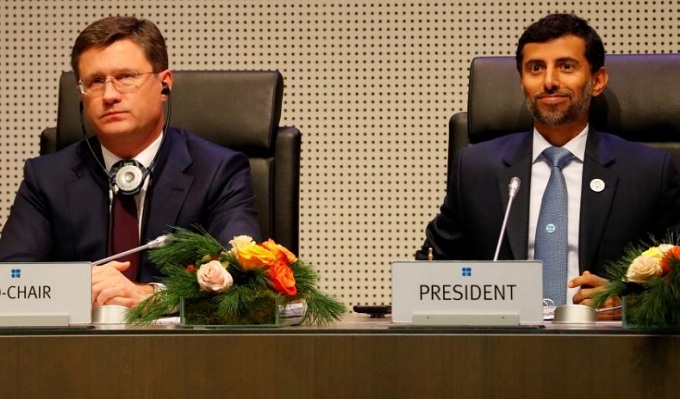



Russian Energy Minister Alexander Novak and UAE's Oil Minister
Suhail Mohamed Al Mazrouei attend a meeting in the OPEC headquarters in Vienna,
Austria December 7, 2018. (Reuters)
The aforementioned deal to cut crude oil production could be seen
as a success of the 174th meeting of OPEC member nations and
partners that recently concluded in Vienna, Austria. Since the end of 2017, the
output of the world’s biggest oil producers, including OPEC, Russia and the US,
has increased by 3.3 million barrels, bringing oil production to 56.38 million
barrels a day, meeting 60% of the world’s demand. However, a sharp increase in
supplies and a fall in global demand have pushed crude oil prices down 30% in
the last two months. In light of falling oil prices, Russia and Saudi Arabia
have agreed to renew the treaty on oil production cuts. Iran has also
"greenlighted” the reduction of oil output by around 800,000 barrels a day
starting from 2019, after reaching an agreement with Saudi Arabia on the
possibility of exemption from production cuts under US sanctions.
As many countries outside OPEC, including the US, do not want to
cut oil production, it is a tough decision for many OPEC producers and allies
to cut supplies in order to push up oil prices. Immediately ahead of the OPEC
conference in Vienna, US President Donald Trump had "reminded” that OPEC would
keep the flow of oil and not make a decision to push up oil prices. The White
House boss also stressed that oil-consuming countries were part of the OPEC
discussions even if they did not attend the Vienna meeting. In addition,
non-OPEC exporters are even planning to increase oil output, with the US taking
the lead. The US President once suggested that OPEC strengthen its oil
production to mitigate the impacts of US sanctions against Iran. Meanwhile,
even Iraq, a major oil producer within OPEC, does not actually want to cut
production because the country is currently in need of oil revenues for the
reconstruction of the country. Russia, a major non-OPEC producer, is not so
urgent in increasing oil prices as its economy is more diversified and its
domestic currency, ruble, is less dependent on the oil market. Saudi Arabia,
meanwhile, is believed to want to push up oil prices aiming to help balance the
budget deficit caused by sharply falling oil prices.
According to analysts, OPEC’s decision to cut oil output will have
a direct impact on the next proceedings in the oil market. If OPEC failed to
make a significant cut in production, the sharp drop momentum in oil prices
would undoubtedly continue spreading into 2019. So, immediately following the
decision of the OPEC members and partners to cut production at a "temporarily
sufficient rate”, oil prices suddenly increased by 5%. The prices of Brent
crude rose US$3.26 per barrel to be traded at US$63.32. The price of West Texas
Intermediate (WTI) crude was up US$2.62 to US$54.11 per barrel before declining
by US$53.9. A source from Russia’s Energy Ministry said Moscow is ready to cut
roughly 200,000 barrels a day, while non-OPEC countries may cut an additional
200,000 barrels per day, bringing the total cut output up to 1.2 million
barrels a day.
The meeting between the OPEC and non-OPEC members comes at a time
when the oil market is near the bottom of its worst price plunge since the 2008
financial crisis. Since its peak in early October, global oil prices have
fallen sharply for fear of excessive supply and a decline in global stocks, as
well as a slowdown in economic growth in certain countries. The newly made cut
is considered to be in line with the market’s expectations. Analysts forecast
that the move of OPEC and its allies would help cut supplies in the oil market,
as previous forecasts suggested that non-OPEC producers will increase their
output by 2.4. million barrels per day next year, with US oil output continuing
to rise strongly. US government data shows that the country is currently
exploiting oil with an unprecedented high output of 11.7 million barrels a day.
Although the deal to cut oil production reached by OPEC and its
partners is somewhat reluctant, it is a positive sign of a "handshake” between
OPEC and the non-OPEC members aiming to stabilise oil prices. With this move,
the "black gold” market is expected to flourish after oil prices were recently
near the bottom.
Source: NDO